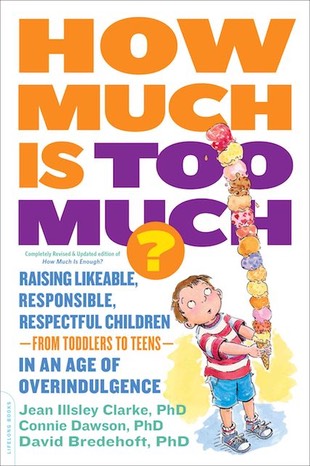It could be that children today are more overindulged than we were, but then again, doesn’t every generation look back on their own formative years through rosy glasses, and at the generation directly following them with critical eyes wide open?

Approximately 2,350 years ago, Socrates made the following observation about children in his time. “The children now love luxury; they show disrespect for elders and love to chatter in place of exercise. Children are tyrants, not the servants of their households. They no longer rise when their elders enter the room. They contradict their parents, chatter before company, gobble up dainties at the table, cross their legs and tyrannize over their teachers”[1]. If we fast-forward and update Socrates’ words, his observation sounds very much like children in 2004.
One way to think about the question, are today's children more overindulged than children growing up in the past? is to look at the today's numbers. Read through the following facts and then you can decide for yourself.
Overindulgence Today by the Numbers
• A 2001 Time/CNN poll found the following[2]:
1. Are children today more or less spoiled that children 10 or 15 years ago? 80% more.
2. Are your own children spoiled or not spoiled? 68% very/somewhat spoiled.
3. Do children today have to do fewer or more chores? 75% fewer.
4. Are your children exposed to too much advertising when it comes to toys and games they might buy? 71% too much advertising.
• Companies spend an estimated $14.4 billion dollars annually to advertise products to kids[3].
• Children become brand conscious by age 3, and half of them ask for specific brands by age 5[4].
• Children influence parental decisions to the tune of $290 billion annually[5].
• Children 18 and under spend $150 billion dollars each year[6].
• Americans under 25 spend 5 times more money than their parents did at that age[7].
• The average credit card debt for college freshmen is $1533[8].
• The average credit card debt for college seniors is $3262[9].
• 4% of college freshmen have credit card debt over $7000[10].
• 9% of college seniors have credit card debt over $7000[11].
• 31% of college seniors have credit card balances of $3000 - $7000[12].
• Experts figure the annual tween-age (5-12 yr. olds) buying power at about $85 billion[13].
• U.S. teens spend on average $80.00 per shopping trip to the mall[14].
• 33% of 8-12 year-olds own a cell phone[15].
• Average back to school spending per family in 2003 was $450.76 for a total of $14.1 billion dollars[16].
• A growing number of parents are leaving school shopping to their tween-age children. They send them to the mall with money and little or no guidance[17].
• 25% of parents believe that their children manage money extremely well at the same time 50% of teenagers (14-16) say they’ve received little or no financial advice from their parents[18].
• The fastest growing bankruptcy rate is from among adults under 25[19].
• A recently released study found that 15%of girls and nearly 14% of boys in the US are classified as obese. When compared to their counterparts, American teens lead the world in obesity[20].
• One third of U.S. children aged 4 to 19 eat at least one fast-food meal daily and take in 187 calories more a day than those that don’t, for and average of 6 extra pounds a year[21].
• The average U.S. child watches 10,000 food advertisements on TV each year[22].
• On average a child spends 4 hours in front of the TV each day and views 40,000 commercials per year[23].
• A recently released study found that for every hour of TV watched daily by 1 and 3-year-olds there was a 10% increased risk of attention deficit problems by age 7[24].
• In the 3-year-old group: 7% no TV; 44% 1-2 hours; 27% 3-4 hours; 11% 5-6 hours; 10% 7+ hours a day[25].
• Of the typical 48 hours spent weekly on household chores, children average 6 hours, husbands 10, and wives 32[26].
• 56.9 percent of 16- to 19-year-olds worked or looked for a job last summer -- the lowest percentage since 1964, according to the Labor Department's Bureau of Labor Statistics. The rate has been declining steadily since 1978, when it peaked at 69.1 percent[27].
• A 2001 US Department of Agriculture report stated that a husband and wife family earning $65,800 annually or more will spend $249,180 to raise a child from birth to age 17[28].
Now that you have read the numbers how would you answer the question? Are children more overindulged today than we were?
Tips for avoiding overindulgence
• Set limits on how much TV your children can watch and enforce them.
• Teach your children to do chores (read Pick Up Your Socks…and Other Skills Growing Children Need by Elizabeth Crary for ideas on how to do this http://www.parentingpress.com/a_ecrary.html).
• Talk about money management with your children. I suggest Nathan Dungan’s Share save spend techniques as a guide: www.sharesavespend.com.
• Educate your children about the manipulative effects of advertisements. Teach the difference between wants and needs.
• Become a good role model for your child. Talk the talk and walk the walk.
• Set a goal of eating one well-balanced meal as a family each day.
• Limit the number of fast food meals you and your children consume.
There is more help about avoiding overindulgence in How Much is Too Much? Raising Likeable, Responsible, Respectful Children – From Toddlers To Teens – In An Age of Overindulgence (2014, DaCapo Press Lifelong Books).
References
[1]Bartleby.com. http://www.bartleby.com/73/195.html
[2] Reported by Nancy Gibbs. (August 6, 2001). Who’s In Charge Here? Parents Agree That Children Today ar Spoiled. But a Rising Number are Fighting the Tendency to Indulge and Coddle them. Time. pp.40-49. http://www.time.com/time/covers/1101010806/index.html. Original source: Time/CNN Poll, July 17-18, 2001 by Harris Interactive. Sampling error is + 3.1%.
[3] Margaret Magnarelli. (March, 2004). Big Spenders. Parents. pp. 146, 244-247.
[4] Margaret Magnarelli. (March, 2004). Big Spenders. Parents. pp. 146, 244-247.
[5] Margaret Magnarelli. (March, 2004). Big Spenders. Parents. pp. 146, 244-247.
[6] Reported by John Ewold “Dollars & Sense.” (July 24, 2003). Kids are Spending Big Bucks. Minneapolis Star Tribune. Section E, pp. 1, 6.
[7] John Ewold “Dollars & Sense.” (July 24, 2003). Kids are Spending Big Bucks. Minneapolis Star Tribune. Section E, pp. 1, 6.
[8] Reported by Sandra Block. (August 12, 2003). Self-control Key to Managing Credit Card Debty in College. USA Today. Money Secton B, p. 3. Original source: Marie O’Malley. (2003). Educating Undergraduates on Using Credit Cards. Nellie Mae. http://www.nelliemae.com/library/cc_use.html
[9] Reported by Sandra Block. (August 12, 2003). Self-control Key to Managing Credit Card Debty in College. USA Today. Money Secton B, p. 3. Original source: Marie O’Malley. (2003). Educating Undergraduates on Using Credit Cards. Nellie Mae. http://www.nelliemae.com/library/cc_use.html
[10] Reported by Sandra Block. (August 12, 2003). Self-control Key to Managing Credit Card Debty in College. USA Today. Money Secton B, p. 3. Original source: Marie O’Malley. (2003). Educating Undergraduates on Using Credit Cards. Nellie Mae. http://www.nelliemae.com/library/cc_use.html
[11] Reported by Sandra Block. (August 12, 2003). Self-control Key to Managing Credit Card Debty in College. USA Today. Money Secton B, p. 3. Original source: Marie O’Malley. (2003). Educating Undergraduates on Using Credit Cards. Nellie Mae. http://www.nelliemae.com/library/cc_use.html
[12] Reported by Sandra Block. (August 12, 2003). Self-control Key to Managing Credit Card Debty in College. USA Today. Money Secton B, p. 3. Original source: Marie O’Malley. (2003). Educating Undergraduates on Using Credit Cards. Nellie Mae. http://www.nelliemae.com/library/cc_use.html
[13] Reported by Gary Strauss. (March 2, 2004). Princesses Rule the Hearts of Little Girls. USA Today. Life, Section D, pp. 1-2. Original source: U.S. Census estimate.
[14] Reported by John Ewold “Dollars & Sense.” (July 24, 2003). Kids are Spending Big Bucks. Minneapolis Star Tribune. Section E, pp. 1, 6.
[15] Jim Louderback. (September 19-21, 2003). Do Kids Really Need Cellphones? USA Weekend. p. 4.
[16] Bruce Horovitz. (August 11, 2003). More Parents are Leaving School Shopping to the Kids. USA Today. Life Section, pp. D1-2.
[17] Bruce Horovitz. (August 11, 2003). More Parents are Leaving School Shopping to the Kids. USA Today. Life Section, pp. D1-2.
[18] Reported by: Nathan Dungan. (January/February, 2001). Financial Values: To Advertisers, Money Talks – and so do Frogs. Bond. p. 5. Original source: Lutheran Brotherhood/Yankelovich Partners “Kids & Money” survey, July 2000.
[19] Reported by John Ewold “Dollars & Sense.” (July 24, 2003). Kids are Spending Big Bucks. Minneapolis Star Tribune. Section E, pp. 1, 6.
[20] Reported by The Atlantic Monthly. (April, 2004). My Big Fat American Child. p. 44. Original sources: —"Body Mass Index and Overweight in Adolescents in 13 European Countries, Israel, and the United States," Inge Lissau et al., Archives of Pediatrics & Adolescent Medicine; "Effects of Fast-Food Consumption on Energy Intake and Diet Quality Among Children in a National Household Survey," Shanthy Bowman et al., Pediatrics.
[21] Reported by The Atlantic Monthly. (April, 2004). My Big Fat American Child. p. 44. Original sources: —"Body Mass Index and Overweight in Adolescents in 13 European Countries, Israel, and the United States," Inge Lissau et al., Archives of Pediatrics & Adolescent Medicine; "Effects of Fast-Food Consumption on Energy Intake and Diet Quality Among Children in a National Household Survey," Shanthy Bowman et al., Pediatrics.
[22] Jennifer Kaylin. (March/April, 2004). The Belly of the Beast. Yale Alumni Magazine. pp. 31-37.
[23] Margaret Magnarelli. (March, 2004). Big Spenders. Parents. pp. 146, 244-247.
[24] Reported by Lindsey Tanner. (April 5, 2004). TV May ‘Rewire’ Young Brains. Minneapolis Star Tribune. Section A, p. 3. Original source: Dimitri Christakis, M.D., MDPH, Children's Hospital and Regional Medical Center, University of Washington, Seattle; April 2004 Pediatrics. Also reported by: E.J. Mundell. Toddler TV Time May Shorten Attention Spans: Early Exposure Linked to Focus Problems by Age 7, Study Finds. Health Day: http://www.healthday.com/view.cfm?id=518206 .
[25] Reported by Lindsey Tanner. (April 5, 2004). TV May ‘Rewire’ Young Brains. Minneapolis Star Tribune. Section A, p. 3. Original source: Dimitri Christakis, M.D., MDPH, Children's Hospital and Regional Medical Center, University of Washington, Seattle; April 2004 Pediatrics. Also reported by: E.J. Mundell. Toddler TV Time May Shorten Attention Spans: Early Exposure Linked to Focus Problems by Age 7, Study Finds. Health Day: http://www.healthday.com/view.cfm?id=518206 .
[26] Reported by: H. J. Cummins. (December 11, 2000). A Chore No More. Minneapolis Star Tribune. Section E, p. 1, 4. Original source: Scott Coltrane. (2000). Research on Household Labor: Modeling and Measuring the Social Embeddedness of Routine Family Work. Journal of Marriage and the Family, volume 62, no. 4. pp. 1208-1210.
[27] Leigh Strope. (July 5, 2002). Teens shun summer work to stay in school or relax Business; In growing U.S. trend, they'd rather hang out, study than flip burgers. The Detroit News. http://www.detnews.com/2002/careers/0207/29/b03-530004.htm
[28] Reported by: Kate Peterson. (March/April, 2003). Your Quarter-Million-Dollar Baby. Thrivent: A Magazine Serving the Lutheran Community. pp. 12-16. Original source: USDA 2001 study.
All photos from MorgueFile free photo.


